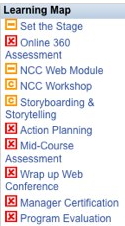At the recent ASTD conference, I was once again faced with the new phrase: talent management. It was being touted as the new focus in HR, was baked into LMS, etc. So naturally I was curious how this related to the performance ecosystem, and had the temerity to call Kevin Wheeler, the guru of talent management, and ask.
Kevin expressed mixed feelings about talent management being the new flavor of the month, given that he’s been talking about it for years! Kevin characterized Talent Management as recruitment, development, and performance, with lots of components under each one. All the activities that accrue around the workforce qualifies, really.
I recognized that the performance ecosystem really deals with development and performance, and hasn’t been about recruitment, though there could and should be an ongoing process identifying new competencies and new needs in professional capabilities. Part of the knowledge work itself may be identifying needed competencies, and a management concern may well be whether to acquire that need temporarily or permanently.
I asked how his model adapted to the increasing changes in competencies with what I foresee as increasing change and decreasing stability in job roles, and he discussed how there’re really two workforces: the core who does the knowledge or concept work, and the rest still doing the mainstream work that could potentially be automated (though that’s a longer term trend, not happening as fast as could be for reasons economic and political). He also suggested that the competencies are shifting from specific skills to more general capabilities, e.g. not knowing a particular programming language, but instead knowing software engineering and having an ability to learn new languages quickly.
Our conversation roamed across the switch in competencies from being compliant and doing what you’re told to being able to deal with ambiguity and solving problems, even questioning authority. Ah, meta-learning. Too bad schools are still working on the old model! Societally, we thought about those folks who prefer to have a simple, predictable job (the majority?) that allows them the freedom to pursue their passions, versus those (the creative class, Kevin termed them) who live to create, design, engineer, the ones who advance our understanding and our lives. There are different roles and needs, and organizations have to adjust to that.
Kevin also proposed that the shift to small and nimble organizations is a pendulum shift that’s been seen before, and that there will be a subsequent shift back; that other paradigm shifts (e.g. agricultural to industrial) had similar dynamics. Food for thought: will the networked era evolve to larger and relatively stable organizations, or is change and the need for nimbleness going to be persistent?
It did appear that at least for the near term, organizations have to balance their investment across maintaining the necessary administrative and support functions, but new investment really should be on those activities that enable new work. Either society needs to slow down (which isn’t an awful thought), or companies are going to have to be able to adapt and innovate for survival, not just execute against a fixed plan.
And that’s where I think the opportunities to improve are. We know a lot about learning and innovation, but we’re not practicing them in the organization. That’s an understanding I’m trying to help develop, and then execute against. On that, I believe Kevin and I are in agreement. A public thanks to him, and a reflection that great conversations are one of the best tools of learning!
 When I went around the room asking what people were hoping to get out of the day, a lot of mentions of LMS and elearning made me realize that the title of “elearning strategy” had perhaps misled people into thinking this was just about courses online, whereas I was going quite a ways further through my performance ecosystem. I took some time to explain that my vision of learning was far beyond courses, and included problem-solving, innovation, and more.
When I went around the room asking what people were hoping to get out of the day, a lot of mentions of LMS and elearning made me realize that the title of “elearning strategy” had perhaps misled people into thinking this was just about courses online, whereas I was going quite a ways further through my performance ecosystem. I took some time to explain that my vision of learning was far beyond courses, and included problem-solving, innovation, and more.
 What I like about it is it takes a longer term view of skills. The sample he showed (and of course I realize it’s presented in the best light) was a learning map for a course, but with lots of components spread out over time (sample map shown). There’s a priori assessment, content, activities with managers, etc.; a mix of activity, practice, reflection, just the sort of model we should be designing. We know spaced practice matters, with reactivation, reflection, etc. It’s also valuable to go back to the workplace, and then check-in later to see how things are going. It’s a fuller picture of what learning’s about.
What I like about it is it takes a longer term view of skills. The sample he showed (and of course I realize it’s presented in the best light) was a learning map for a course, but with lots of components spread out over time (sample map shown). There’s a priori assessment, content, activities with managers, etc.; a mix of activity, practice, reflection, just the sort of model we should be designing. We know spaced practice matters, with reactivation, reflection, etc. It’s also valuable to go back to the workplace, and then check-in later to see how things are going. It’s a fuller picture of what learning’s about.